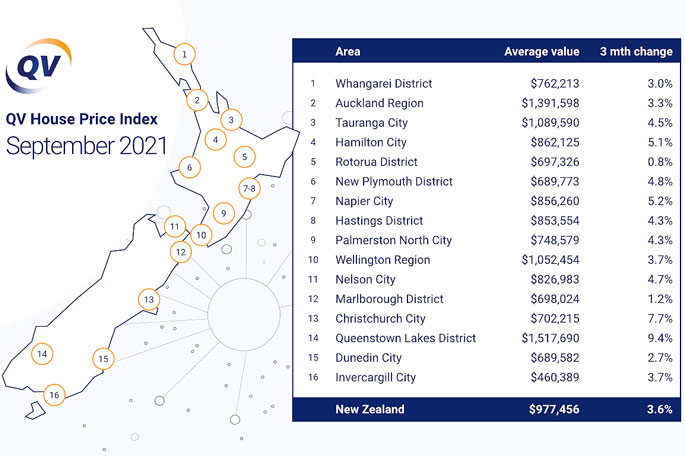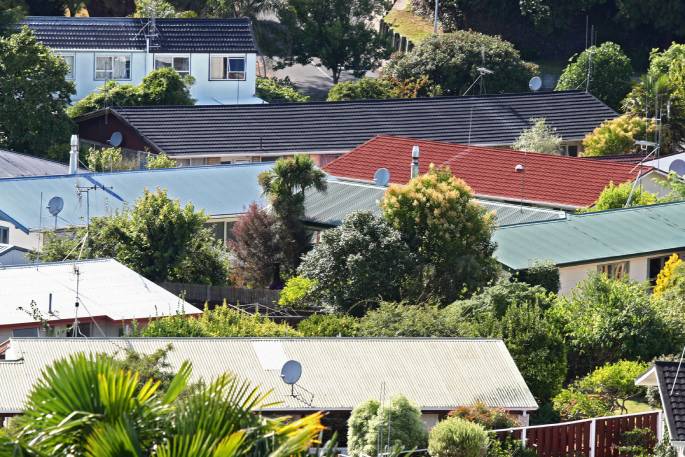The property market continues to rise, even as lockdown levels continue to restrict the entire country to some degree.
The average value increased 3.6 per cent nationally over the past three-month period to the end of September, up slightly from the 3.3 per cent quarterly growth we saw in August, with the national average value now sitting at $977,456.
This represents an increase of 26.3 per cent year-on-year, down a fraction from 26.6 per cent last month.
In the Auckland region, the average value now sits at $1,391,598, climbing 3.3 per cent over the last three-month period, with annual growth of 23.9 per cent dropping slightly from August's year-on-year growth of 24 per cent.
QV general manager David Nagel says they've seen mixed results around the 16 main urban areas we monitor with seven centres continuing the recent trend of a gradual slowdown in the rate of growth.
"However, nine urban areas have bucked this trend showing a rebound with increasing rate of growth compared to last month."
Nagel says ongoing lockdowns are continuing to impact the number of fresh listings, particularly in Auckland and this has possibly contributed to another strong month of value growth, with buyers continuing to vie for limited stock.
"We're hearing anecdotal evidence from agents that appraisal enquiries are on the rise in many locations – a great signal that spring might finally provide the listings we'd normally expect.
"A flood of new listings will provide some welcome relief for house hunters. With the recent OCR announcement and flow-on increases in mortgage rates, combined with tightening credit limits and interest deductibility changes kicking in from October, we could see a gradual swing in the power balance between buyers and sellers over the coming months.
"But it's difficult to foresee anything more than a gradual slowing in the rate of value growth in the foreseeable future."
The strongest value gains for the main cities over the past three months have come from Queenstown Lakes District at 9.4 per cent growth in value, well up from 2.9 per cent value growth last month, followed by Christchurch at 7.7 per cent growth, building further on the strong three-monthly rate of growth of 5.8 per cent reported last month.
None of the major urban areas QV monitors have seen a decline in average value, but Rotorua continues to slow at 0.8 per cent compared to its rolling three-monthly growth rate of 1.9 per cent last month.
Central New Zealand continues to show the strongest annual rate of value growth, with three of the four fastest growing regions all in the lower North Island.
Values in the Manawatu-Whanganui region have grown 35 per cent in the past year, while the Hawke's Bay and greater Wellington regions have experienced annual growth of 33.2 per cent and 32.3 per cent respectively.
West Coast has the strongest annual rate of growth in the South Island at 32 per cent.
The three lowest annual growth rates are all in the South Island, with the Southland region experiencing a still-significant 20.3 per cent increase, with the Tasman region showing 22.3 per cent and Otago at 23.3 per cent annual growth.

Tauranga
House price growth continues to ease back in Tauranga, slowly but surely.
The city's rolling three-monthly rate of house price growth has edged down from a January peak of 10.5 per cent to just 4.5 per cent in September. There have been growth spurts along the way − including another 10.2 per cent spike in May − but price rises have been trending down for four consecutive months now.
However, house prices in Tauranga still increased by 1.5 per cent last month and remain 32.6 per cent higher than they were 12 months ago, making it 'one of the New Zealand's leading New Zealand cities for house price inflation”, according to QV property consultant Derek Turnwald.
'After Auckland, Tauranga is now probably the least affordable city in New Zealand for housing. It's become extremely difficult for first-home buyers to get on the ladder here,” he said.
'The main feature of the current market is a lack of listed properties − although this has improved from last month when lockdown impacted upon the market. Suppliers of home renovation supplies report very strong demand for supplies at the present time. It would seem that much of the money saved during lockdown and deferred from not being able to travel overseas is being put into home renovations and redecoration.”
Waikato
Residential property prices increased by an average of 1.2 per cent across the Waikato region in September.
The region's rolling three-monthly average growth rate dropped slightly from 6 per cent in August to 5.1 per cent in September, with the districts of Waikato (7.1 per cent), Taupo (6 per cent), and Waipa (6 per cent) making the greatest gains this quarter.
In Hamilton, property prices have increased by 5.1 per cent over the last three months to reach a new average value of $862,125. The biggest increase over that time was in the city's northeast (8.1 per cent), which surpassed a $1m average price tag for the first time in September. The smallest increase was in central Hamilton and the southwest, where values grew by just 0.8 per cent and 2.4 per cent respectively.
Local QV property consultant Tom Schicker commented: 'Over the last three months the median house price in nearly all Waikato districts has continued to perform strongly − with the exception of the southern districts of Waitomo, South Waikato, and Otorohanga, which all saw small decreases.
'Small towns in close proximity to Hamilton city continue to perform well and see high demand, including Morrinsville, Te Awamutu, Cambridge and Ngaruawahia, with developers seeing these places as hotspots for development also.”
'Local agents continue to report a shortage of quality listings across the Waikato with a good level of interest in the properties that are on the market, especially ones with any development potential, or that appeal to first-home buyers,” Mr Schicker added.
Rotorua
Is all the steam coming out of Rotorua's residential property market?
House prices in Sulphur City have increased by an average of just 0.8 per cent over the past three months, down from last month's rolling three-month average of 1.9 per cent, and a significant drop from its peak growth rate of 7.6 per cent back in June.
'House prices are increasing at a decreasing rate month-on-month,” local property consultant Derek Turnwald said. 'Although sales remain strong across Rotorua as a whole, much fewer people are attending auctions and open homes, and we're seeing more properties being passed in at auctions now.”
Mr Turnwald said investor activity had also dropped off in recent months in response to LVR changes, the extension of the brightline test, and tax deductibility law changes. 'There hasn't been a noticeable increase in investors selling properties yet. Some may choose to wait a couple of years to dodge being taxed under the new extended brightline period,” he added.
Provincial centres, North Island
The Bay of Plenty town of Kawerau has experienced the most house price growth as a percentage this quarter (14.6 per cent), followed by Central Hawke's Bay District (7.5 per cent) and last month's leader, Waikato District (7.1 per cent).
It's a completely different story in terms of annual house price growth, with Horowhenua (38.6 per cent) leading and Whanganui (37.1 per cent) and Taupo (36.3 per cent) in second and third place respectively.



0 comments
Leave a Comment
You must be logged in to make a comment.